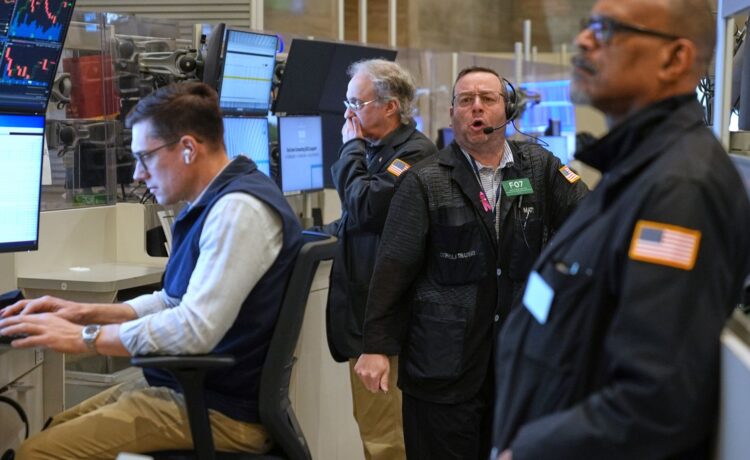One of the questions being asked in financial media circles is how, under conditions of rising geo-political and geo-economic turmoil, the US stock market is able to continue its surge, reaching record highs on a regular basis.
As long-time columnist John Plender of the Financial Times (FT) noted recently: “The behaviour of equity markets over the course of this extraordinary year has come close to matching the dictionary definition of levitation. The Trump trade war, spiralling fiscal deficits and public debt, pervasive geopolitical risk, the radical dismantling of the postwar international order, declining global growth prospects—all have failed to hold back the magical rebound after investors’ initial panic over Donald Trump’s erratic on-off tariff tantrums.”
The events of April, following Trump’s announcement of his economic war against the world through the imposition of so-called reciprocal tariffs, underscored the inherent instability of the stock market boom and the global financial system more broadly.
Usually in times of turbulence there is a move into US financial assets, in particular Treasury bonds, in the search for a safe haven. In this case, however, the reverse happened. Treasury bonds, supposedly the safest asset in the world, were sold off, causing a spike in interest rates. Contrary to previous experience, the US dollar was sold off in international currency markets.
Questions were raised about its viability as the basis of the global monetary system as the theme in financial markets became “sell America,” sending Wall Street down.
But since April 8, the nadir of the Wall Street fall, the S&P 500 index has risen 29 percent in just four months and is now 5 percent above the previous market high in February. Market sentiment, according to Morgan Stanley, has reversed “from uncertainty and fear to bullish optimism, and the economic outlook from recession to a disinflationary capital-spending boom.”
However, the surge, which suffered a blow yesterday when tech and AI stocks fell, is lopsided in the extreme. It is dominated by tech stocks with the earnings of the so-called “Magnificent Seven” growing at an annual rate of 26 percent while they have barely increased for the other 493 in the index.
The extremely unbalanced character of the boom is further highlighted by data on the 10 largest stocks by market capitalisation in the S&P 500. They are dominated by tech firms led by chip business Nvidia, the first company whose market value went over $4 trillion, and include Microsoft, Alphabet, Apple, Amazon, Tesla, Meta, Broadcom, Berkshire Hathaway and JPMorgan Chase.
Together, according to figures published by FT columnist Robert Armstrong, they account for: 40 percent of the S&P 500; 56 percent of the increase of the S&P since April 8; 31 percent of the increase in revenue for S&P companies over the past 12 months; 55 percent of the growth in net income over the index for the past 12 months (despite a fall in net income over that period for Apple, Tesla and Berkshire); and 69 percent of the growth of capital spending across the index over last 12 months.
Armstrong pointed to a vast change which has taken place in the structure of American capitalism over the past several decades. Some 30 years ago the leading companies were industrials, energy, consumer staples, and tech.
Today, the top eight companies out of the top 10 are tech firms with the remaining two being finance.
This transformation has brought about a significant shift in asset holdings and the mode of profit accumulation.
The assets of major companies in the S&P in the past were physical assets, such as factories, equipment and inventories. But today, according to an article by FT columnist Tej Parikh, “around 90 percent of their assets are intangible, ranging from intellectual property, brand value and networks, to code, content talent and knowledge.
In the US, he noted, investment in intangible assets passed tangible investments as a share of GDP in the late 1990s, and the gap has widened ever since. “For all intents and purposes, the US has become an intangibles driven economy.” That may be something of an overstatement, but it points to significant changes.
There is a change in the mode of profit accumulation in key sections of the economy. Industrial firms, for example, sought to increase their profits through greater investment in plant and equipment. But the tech firms increasingly rely on parasitic forms of accumulation.
The profits made by Apple, for example, depend on the monopoly they have on their operating systems for which they charge what is essentially a rent. If the price of an Apple phone were based on the cost of its components, then its retail price would be reduced by hundreds of dollars.
Enormous benefits are to be derived from being the first mover in the tech and AI field and thereby establish, if not a monopoly, then at least a dominant market position. Hence the push to invest in the establishment of AI facilities which has been one of the drivers of the share prices of AI firms as speculative finance flows in, based on the hope that it has picked “the next big thing.”
FOMO (fear of missing out) is a motive force. A company’s shares rise not because of the intrinsic value of its product but because more money is flowing into the markets to buy its shares, giving the market the appearance of a Ponzi scheme.
There are also significant changes in the financing of corporations which are having an impact on share prices. Major corporations are increasingly relying on debt and leverage, rather than raising money through new share issues.
Here they have benefited from the operations of central banks, led by the US Federal Reserve, pumping trillions of dollars into the financial system in response to its deepening crises, starting with the crash of 2008.
This was followed by the crisis of March 2020 when the US Treasury market, the basis of the global financial system and supposedly the safest in the world, froze.
Its collapse was only prevented by the injection of still more money by the Fed coupled with government bailouts. But no sooner had this crisis passed than another erupted with the run on Silicon Valley Bank and First Republic in March 2023, when interest rates rose and devalued the Treasury bonds they were holding. This required the Fed and other government authorities to step in to organise a bailout not only of the banks involved but also with an implicit guarantee to all the others.
A paper published in June 2024 by two Stanford economists, John H Cochrane and Amit Seru, summarised this experience:
“Too big to fail is enshrined. But small companies get bailed out too, and their creditors. Industrial companies, not just financial companies, are protected. Too leveraged to fail might be the summary of our new regime. But our authorities subsidise leverage, with tax deductions and preferences for debt. As a result, there is every incentive to take risk, to borrow and to lend, with confidence that the government will backstop debt, prop up prices and keep companies afloat should any serious crisis develop.”
The response of authorities to the series of crises is not to probe the systemic problems they reveal or examine what they call a “massive institutional failure.”
“They just pat themselves on the back for saving the world with a river of money, move on, and nobody has any concern that the same fragilities remain, are larger, and that the bailout will also have to be larger next time.”
However, as Cochrane and Seru note, the bailout loop cannot continue indefinitely, as everything is finite “including the US government’s ability to borrow real resources in a crisis.”
Another factor in the share market boom—above all in major stocks—demonstrating its essentially parasitic character, is the expansion of share buybacks.
Up until 1982 this practice was illegal as it was deemed to be market manipulation. But since the law was changed under the Reagan administration, at the start of the financialization of the American economy, it has become standard operating procedure.
According to a report in the Wall Street Journal last week, US firms are buying their shares back at a record rate, having announced $983.6 billion worth of purchases so far this year, a total which is expected to rise to $1.1 trillion by the end of the year, an all-time high.
The biggest buyers include Apple and the Google parent, Alphabet, as well as big banks such as JP Morgan, Bank of America and Morgan Stanley.
“Buybacks have been particularly concentrated at the top,” the Journal report said, “with the 20 largest companies accounting for almost half of repurchases. This year’s biggest buyback authorizations are from big tech firms, the beneficiaries of the boom in artificial intelligence stocks.”
Nothing could more clearly illustrate the rot which lies at the heart of the stock market boom.
More than $1 trillion is being outlaid this year, with more to come in the future, not to finance new investment or productive capacity and expand employment, let alone to tackle the myriad social and economic problems confronting US society.
It is being used entirely to boost the assets of the ultra-wealthy, including the CEOs and financial officers of major corporations and banks who receive bonuses, running into the tens, sometime hundreds of millions of dollars, based on the rise of the stock price of the companies they head.
The stock market boom, hailed by Trump and many others as an expression of the health of the US capitalist economy, is in fact a fever chart of its diseased character and the harbinger of yet another financial crisis.
The World Socialist Web Site is the voice of the working class and the leadership of the international socialist movement. We rely entirely on the support of our readers. Please donate today!





